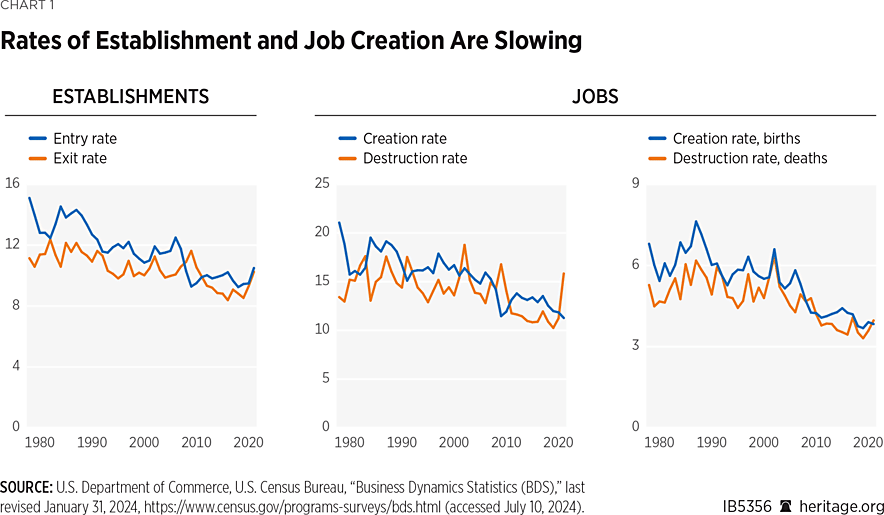Business dynamism—the process by which firms are born, grow, shrink, and die—is a fundamental driver of innovation and economic growth. However, the United States has experienced a worrying decline in this dynamic activity over recent decades.
An understanding of the reasons for this decline is essential for crafting effective policy responses. This Issue Brief covers three major factors contributing to the reduced business dynamism: labor market frictions, financial frictions, and regulatory costs. By reducing barriers to entrepreneurship and creating a market that is conducive to new businesses, policymakers can promote the development of innovative goods and services and clear a path for more Americans to build wealth.
Creation of New Firms and New Jobs Has Slowed
Data from the Census Bureau show the magnitude of the decline in business dynamics.REF
The establishment entry rate has declined from around 14 percent in the early 1980s to around 10 percent in recent years. Establishments are fixed physical locations where economic activity occurs. A firm can have many establishments. There was a sharp drop following the Great Recession in both the entry rate and the exit rate.

New firms and establishments typically create jobs as they open. Consequently, the decline in establishment entry is reflected in the job creation rate. The job creation rate from firm births in particular is now almost half of its peak value.
Why Business Formation Is Declining
At least three factors—labor market frictions, financial frictions, and regulatory costs— could explain why business dynamism is declining.
Labor Market Frictions. Current policy has several departures from at-will employment and other frictions that reduce the fluidity of the labor market.REF
First, occupational licensing places restrictions on who can work in certain careers. Many of the restricted occupations are particularly suited to small-scale entrepreneurs such as those in construction and home services, entertainment and hospitality, and health and personal care services.REF
Second, the potential for lawsuits associated with wrongful termination of protected worker classes raises the costs for firing employees. The risk of a lawsuit raises uncertainty, which causes firms to slow their hiring and firing.REF The effect is stronger for firms with fewer than 50 workers and for firms with more volatile business situations, so it will particularly affect start-up businesses.
Third, employer-provided health insurance can deter workers from switching jobs, particularly to join entrepreneurial firms. Smaller firms are less likely to offer health insurance than larger firms are;REF new firms are less likely to offer insurance than older firms are; and self-employed workers are less likely to have insurance than other workers are.REF Employers who face higher labor volatility may be more reluctant to offer insurance because of problems with adverse selection.REF
Financial Frictions. Financial frictions could hamper the ability of new firms to access capital. Entrepreneurs need to raise financial capital to fund their businesses. Early-stage entrepreneurs typically borrow from banks or take equity investments from private investors. In later stages, they may issue equity traded on a public exchange as their firms grow.
The banking industry has significantly consolidated over the period in which business dynamism has declined. The number of commercial banks has fallen from 14,434 in 1980 to 4,036 in 2023.REF Consolidation and a shift to larger banks can reduce the availability of credit to small businesses.REF Larger banks tend to rely more on formulaic methods to evaluate businesses, which may be harder for small and new firms to satisfy.
Entrepreneurs who do not obtain debt financing from banks can look for equity financing from private investors. However, the Securities and Exchange Commission (SEC) places limits on who qualifies as an accredited investor.REF These limits reduce the availability of capital for entrepreneurs and start-up firms.
Saving and building capital is a necessary part of entrepreneurship. The presence of financial frictions can explain some differences in wealth distribution associated with entrepreneurs. Entrepreneurs may have more wealth because they save more, both to get around borrowing constraints and to counteract the increased risk associated with starting a new business.REF
Regulatory Costs. Regulations impose additional costs and complexity that burden new and small firms. The U.S. regulatory code includes over 1 million different restrictions, and the burden has increased at least 20 percent since 1997.REF Regulation impedes establishment entry and job creation, particularly job creation associated with new establishments.REF
Consequences of Declining Business Dynamism
Fewer new firms means fewer new jobs. New firms create more jobs proportionally. Firm start-ups account for only 3 percent of employment but almost 20 percent of gross job creation.REF In particular, high-growth businesses account for almost 50 percent of job creation.REF
Fewer jobs can slow wage growth because workers typically see faster wage increases when moving to a new position. Over the previous five years, job switchers saw a median annual increase in wages of 5.4 percent compared to 4.2 percent for job stayers.REF
Fewer new firms also slows innovation and productivity growth. New firms often introduce new products that are more efficient than existing ones. Adjustment frictions prevent reallocation of resources from less efficient firms to more efficient firms.
Compounding the effect, fewer new firms reduces competition for incumbent firms. The presence of new firms in an industry can force incumbent firms to innovate and cut costs to remain competitive, benefiting consumers through lower prices. Recent evidence suggests that industries with larger markups see more entry because elevated markups increase profits.REF As firms enter, the competition reduces markups and brings prices down. However, if new firms face additional headwinds against entering markets and fewer firms enter, prices will remain higher for consumers.
Additionally, limited entrepreneurship closes off a path for upward mobility for many workers. Families that own their own businesses show higher increases in wealth than families that do not.REF Though there is a perception that the wealthiest families are inherited dynasties, the share of the Forbes 400 who made their own wealth rose from 40 percent in 1982 to 69 percent in 2011.REF Households that do not start businesses themselves still benefit if they can invest in businesses before they are fully mature and share in the firms’ growth.
Policies to Encourage Entrepreneurship and Innovation
The preceding analysis points to potential changes that policymakers should consider to reverse the decline in entrepreneurship.
- Reduce occupational licensing requirements. States need to balance the need to properly inform and protect consumers with the objective of allowing as many people as possible to work and earn a living. States should reduce licensure requirements, keeping them only in cases where preparation improves the quality of work, licensing effectively screens the quality of candidates, customers suffer harm from poorly conducted work, and customers find it difficult to distinguish between qualified providers.REF
- Individualize health insurance. Many workers have health insurance that is tied to their employment because employer-sponsored health insurance (ESI) receives favorable tax treatment. Reforming the tax preference for ESI would encourage the development of an individual health insurance market.REF Workers could then keep their plans as they moved from job to job. Continuity in health insurance would reduce the risk associated with entrepreneurship.
- Improve entrepreneurs’ access to capital. The SEC or Congress should reduce the limits on accredited investors in order to increase the potential pool of funding for entrepreneurs.REF Greater availability of early-stage financing would make entrepreneurship more attractive by lowering the cost of capital. Additionally, reducing or removing the regulatory compliance costs associated with being a public company would make it easier for entrepreneurs to tap public capital markets.REF
- Repeal stock buyback taxes. The Inflation Reduction Act introduced a 1 percent excise tax on stock repurchases and “economically similar transactions.”REF Supporters of the tax argue that some firms use repurchases, which are exchanges of an asset for another asset, to avoid paying taxes on dividends, which are considered income. However, repurchases and dividends are not necessarily substitutes, nor do managers see them as close substitutes.REF Stock buybacks allow firms without productive investment opportunities to return financial capital to shareholders, which increases the supply available to fund more productive investments. An excise tax on repurchases is another financial friction that will discourage firms from releasing that financial capital to the broader market. Subsequently, start-up firms would face higher debt and equity financing costs or be unable to obtain financing at all.
- Implement full and immediate expensing for research and development expenditures. The Tax Cuts and Jobs Act requires businesses to expense R&D expenditures over five years.REF Delaying when firms can recognize the expense decreases the return on those expenses and discourages R&D. State-level research and development tax credits have been shown to increase entrepreneurship.REF Full and immediate expensing for research and development spending would remove the tax burden hampering entrepreneurship and innovation.
Conclusion
Starting a business is one of the most rewarding ventures an individual can undertake. When a need in the market goes unfulfilled, entrepreneurs need to capitalize on the opportunity. In doing so, they create goods and services that benefit consumers. However, the decline in business dynamism in the United States poses a significant threat to this vital engine of economic growth.
The challenges highlighted in this Issue Brief—labor market frictions, financial barriers, and regulatory burdens—are substantial but not insurmountable. With thoughtful policy changes, we can reverse the troubling trends and rekindle the spirit of entrepreneurship across America. Policy changes can create a vibrant, dynamic economy where new businesses thrive, innovation flourishes, and everyone has the opportunity to build a prosperous future.
Parker Sheppard, PhD, is Director of the Center for Data Analysis at The Heritage Foundation.
This piece is a part of The Heritage Foundation’s Wealth and Innovation project which stands to defend and promote the freedom to innovate, create and use wealth. These are essential to the delicate process by which innovators and entrepreneurs work to build a prosperous and purposeful society.




